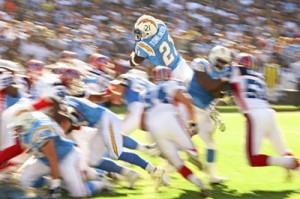I am using the following scoring system throughout this series: 1 point per 20 yards passing, 1 point per 10 yards rushing/receiving, 4 points per passing TD, 6 points per rushing/receiving TD, 0.5 points per reception.
In 2006, Tomlinson rushed for 1,815 yards with 28 TDs, caught 56 passes for 508 yards and 3 touchdowns, and even threw for 20 yards and two touchdowns. He totaled a still mind-boggling 455.3 fantasy points. On a per game basis, Tomlinson averaged 28.46 FP/G, while the baseline — which for these purposes is RB24 [1]Baselines used in this series: From 1968 to 2014, RB24. In ’66 and ’67, RB20, and from ’61 to ’65, RB16. In the 1960 AFL, the baseline is RB6, while it is RB8 in the NFL. From … Continue reading — was at 10.75 FP/G. Therefore, Tomlinson averaged 17.71 FP/G over the baseline, and he did it for 16 games, giving him a VBD of 283.3 fantasy points (17.71 x 16).
By using per game averages, we more closely approximate the way fantasy football really works, and that helps out Holmes in 2002. That year, he rushed for 1,615 yards and 21 touchdowns, while producing an impressive 70-672-3 stat line through the air. That comes out to 407.7 fantasy points, but he did that despite missing two games due to injury. Therefore, his per-game average was 29.12 FP/G, even higher than what Tomlinson did in 2006!
The baseline was also slightly lower: in 2002, RB24 scored 155.7 fantasy points, which comes out to 9.73 FP/G. So Holmes averaged 19.39 FP/G above the baseline, the most by any fantasy running back in history. However, that comes out to 271.5 points of VBD, meaning 19.4 for 14 is still not quite as dominant as 17.7 FP/G for 16 games.
What about Simpson? Well, in ’75, he rushed for 1,817 yards and 16 touchdowns, whiel chipping in with 28-426-7 in the receiving game. That’s 376.3 fantasy points, or 26.88 FP/G. The baseline was just 9.35 FP/G, so Simpson was 17.53 FP/G above the baseline. Because his 14-game season was the full year — i.e., he didn’t miss games due to injury like Holmes — we pro-rate those numbers to a full season, and multiply 17.53 by 16 to give him… 280.5 points of VBD. That’s still behind Tomlinson, but good enough for the second best fantasy season by a running back since 1950.
The table below shows the top 200 fantasy seasons using this methodology:
Tomlinson and Marshall Faulk dominate the single-season list, so you won’t be surprised to see them take the top two spots on the career list. Below are the top 125 running backs in fantasy history:
- Not a lot of surprises here. Although there is a certain Hall of Fame running back from Pittsburgh that fares very poorly here.
- Adrian Peterson needs two more good years to really climb these lists. Can he do that?
- Edgerrin James (RB11) is the highest-ranking running back not in the Hall of Fame (well, other than Tomlinson). Does this help his cause? In fact, the five running backs from 11 to 16 (excluding Peterson) all are borderline HOF candidates, and all were active in ’00 and ’01.
- What stands out to you in the career rankings list?
References
| ↑1 | Baselines used in this series: From 1968 to 2014, RB24. In ’66 and ’67, RB20, and from ’61 to ’65, RB16. In the 1960 AFL, the baseline is RB6, while it is RB8 in the NFL. From 1950 to 1959, the baseline used is RB8. |
|---|

